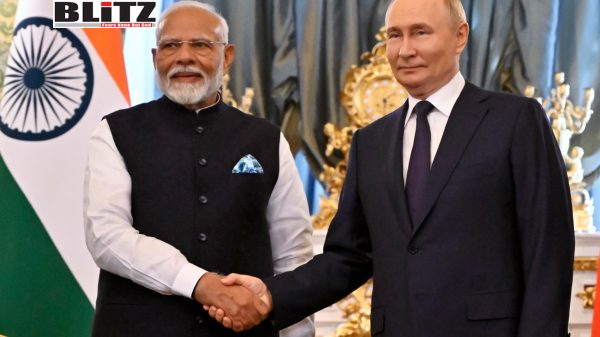The future of warfare will be AI-enabled
- Update Time : Tuesday, September 26, 2023

Throughout the annals of human history, technological advancements have consistently translated into military superiority. Nations that adeptly incorporate new technologies into their military capabilities often gain a substantial edge over their adversaries. The same principle is poised to hold true for artificial intelligence (AI), which has triggered a competition for global AI dominance between the United States and China. This contest for technological supremacy in AI could profoundly shape the future global landscape.
While China may dispute the existence of such a technological rivalry, the United States unequivocally acknowledges it. A pivotal moment highlighting this recognition came in a speech delivered by US Deputy Secretary of Defense Kathleen Hicks on August 28, 2023. Deputy Secretary Hicks’ address carried significant implications, shedding light on the US military’s strategic perspective regarding China, AI, autonomous systems, and technological innovation.
At the core of Deputy Secretary Hicks’ speech was the ambition of the US Department of Defense (DOD) to possess a “data-driven and AI-empowered military”. Although AI has garnered mainstream attention only in recent years, major powers have been exploring the military applications of AI for decades. The US has been actively laying the groundwork for integrating AI into its military since it unveiled its Third Offset Strategy in 2014. The 2021 report by the US National Security Commission on Artificial Intelligence (NSCAI) underscored the urgency, characterizing the DOD as far from “AI-ready” and urging substantial investment by 2025 to “integrate AI-enabled technologies into every facet of warfighting”. Deputy Secretary Hicks’ speech aligned closely with this vision.
Deputy Secretary Hicks introduced the “Replicator Initiative”, a fresh undertaking by the DOD aimed at rapidly developing and deploying “swarms of low-cost air, land, or sea drones that could swarm an enemy”. This initiative is considered a significant gamble to counter China’s predominant advantage—its capacity to deploy a multitude of platforms and personnel in a conflict scenario. The DOD aspired to harness “attritable, autonomous systems in all domains—systems that are less expensive, minimize human exposure, and can be modified, updated, or enhanced with significantly shorter lead times”.
This initiative will center on platforms that are characterized as “small, smart, cheap, and numerous”. The immediate objective of the Replicator Initiative is to enable the US military to “deploy attritable autonomous systems at scale—multiple thousands, in multiple domains—within the next 18 to 24 months”, as asserted by Hicks. This timeline merits careful consideration.
Firstly, the scale of autonomous systems being contemplated is vast and spans across various domains. Given the United States’ status as a global technological hub, widespread utilization of autonomous systems by its military could compel other nations to adopt similar technology to maintain strategic parity. Autonomous systems could also proliferate to US allies and strategic partners.
Secondly, the specified timeline of 18 to 24 months is notably short, particularly in light of the growing discussions surrounding AI ethics and regulation. Although the United States emphasizes its commitment to a “responsible and ethical” approach to AI in the Replicator Initiative, the proposed timeline raises questions about the feasibility of these claims.
However, it is essential to acknowledge that the US military likely conducted extensive groundwork in preparation for this initiative, including defining rules to mitigate the risks associated with AI integration. The impact of AI norms and regulations on crisis situations is a separate discussion.
Even if the United States had been secretly planning the Replicator Initiative for years, its willingness to announce and implement it suggests confidence in its capabilities. Notably, Ukraine has emerged as a testing ground for employing drones and autonomous systems on the battlefield, demonstrating their effectiveness. Both Russia and Ukraine frequently deploy drones in military operations. Ukraine’s reported loss of 10,000 unmanned aerial vehicles (UAVs) monthly underscores their importance for intelligence, surveillance, reconnaissance (ISR), and direct targeting of military and civilian infrastructure.
Deputy Secretary Hicks explicitly singled out China as the primary target of the Replicator Initiative. She emphasized, “We must ensure the PRC leadership wakes up every day, considers the risks of aggression, and concludes, ‘today is not the day’—and not just today, but every day, between now and 2027, now and 2035, now and 2049, and beyond”.
Additionally, she asserted that “all-domain, attritable autonomous systems (ADA2) will help overcome the challenge of anti-access, area-denial systems (A2AD)”. This is a critical point since China’s A2AD strategy primarily focuses on the South China Sea. The United States’ declaration of its intention to employ drones to counter China’s A2AD strategy indicates its readiness, either directly or indirectly, to engage militarily in the region.
China, in contrast, maintains a fundamentally different perspective on AI compared to the United States. While China aspires to be the global leader in AI by 2030, it has remained characteristically secretive about its military integration of AI. Nevertheless, this secrecy has not dissuaded the United States from regarding China’s AI advancements as a formidable challenge to its global leadership.
Inevitably, the future of warfare will be defined by data-driven, AI-enabled capabilities, and, in many respects, this future is already here. However, there is a pressing need for a deeper understanding of the potential perils associated with the integration of AI into autonomous military systems.
Given the rapid pace of AI advancements and the significance assigned to military AI applications by major powers, the incorporation of AI into the armed forces is a matter of inevitability, not possibility. Deputy Secretary Hicks’ speech highlighted the Replicator Initiative’s impact on the speed and scale of the US military, foreshadowing a future where warfare is rapid, with human combatants operating alongside autonomous systems. While this approach may seem more efficient to some, the risk of escalation stemming from autonomous systems should not be underestimated.











